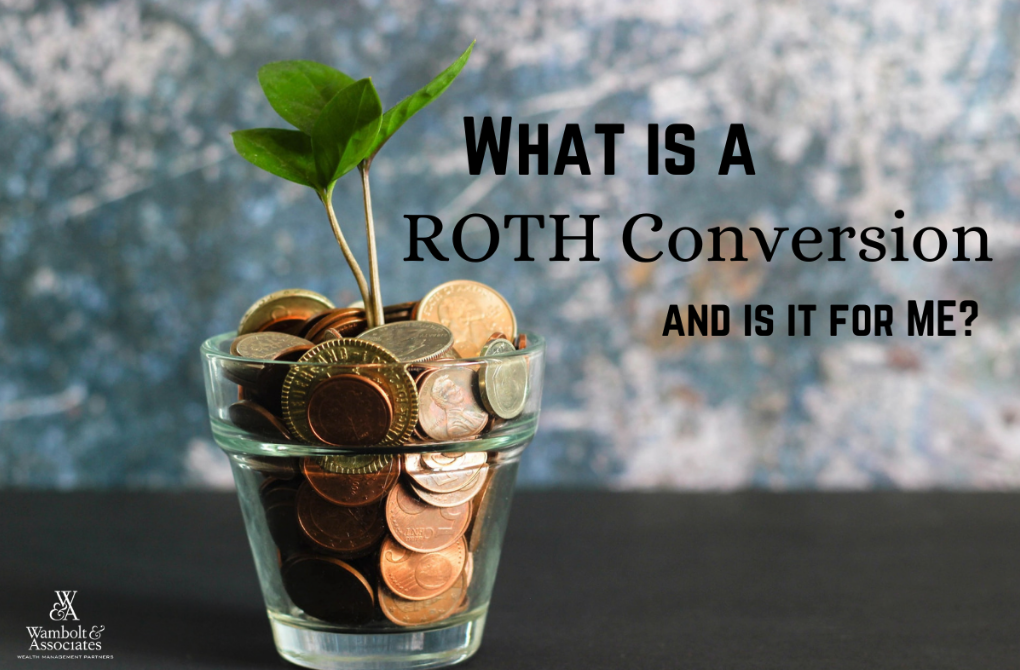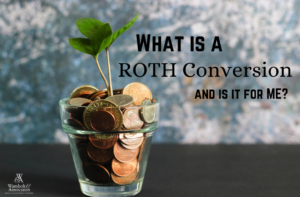
Simply put, a ROTH Conversion is a transfer of all or part of the balance of an existing Traditional IRA to a ROTH IRA.
First, most investors know the difference between a ROTH IRA and a Traditional IRA, but let us provide a quick overview for those who may not be well versed on these differences.
A ROTH IRA is a retirement account that is funded with after-tax dollars. You can take any discretionary savings that you may have accumulated and contribute them to a ROTH IRA. You can contribute up to $6,000 annually and $7,000 if you are over age 50. The money in this account is then invested and the growth on your investments grow tax-free. As you begin withdrawing these funds in retirement, you are not subject to any tax.
A Traditional IRA is a retirement account that is funded through tax deductible contributions. Your annual contributions are deductible on your tax returns. The contribution limits are the same as the ROTH. As you begin withdrawing these funds in retirement, the amount withdrawn is subject to income tax. Remember, as you contributed, the contributions were deducted from your taxes. Once the funds are utilized, you then pay taxes. Consider this IRA as a vehicle for reducing your taxes during your higher income earning years.
Now that we understand the difference between these retirement accounts, let us discuss why a ROTH Conversion makes sense for some investors.
As you know, taxes drive much of our personal financial decisions. It is important to remain diligent to limit the amount of annual tax we pay. If taxes rise in the future due to increases from the government, you could be subject to a higher tax bracket based on your household income.
Prior to 2010, there were limits to ROTH Conversion amounts, but beginning in 2010, the federal government removed the income limit, allowing investors to convert money from their Traditional IRAs to ROTH IRAs, regardless of your household income. One benefit to investors is that it has the potential to lower your taxes in the future. It is impossible to predict what tax rates will be in the future, but with the National Debt currently sitting at $27 trillion dollars, proactive tax planning will help you prepare in the event we are faced with future tax increases.
Another benefit of a ROTH Conversion is that ROTH IRAs are not subject to RMDs, which means you are not required to take an RMD at age 72. This RMD age requirement was recently raised from 70-1/2 to age 72. For those who saved aggressively for retirement in a Traditional IRA, the RMDs may not actually be needed in retirement. These investors with a healthy balance will often take the annual RMD, pay the appropriate taxes, and then reinvest those funds in a non-retirement account. These funds are then subject to capital gains tax on any growth on withdrawals. The benefit of owning a ROTH IRA is having the opportunity to avoid income and capital gains tax liabilities later in life.
Lastly, considering a ROTH Conversion just as you retire and are no longer earning an income presents an opportunity to convert what would have been your annual salary. This does not create an increase to your tax bracket as you swap out one form of “income” for another.
So why not start the process of a ROTH Conversion today?
There are some drawbacks worth considering. The largest disadvantage is incurring a tax bill on any conversion amounts. For example, if you have $100,000 in a Traditional IRA and convert the entire account to a ROTH, you could potentially pay $24,000 in taxes (assuming you are in a 24% tax bracket). In the event you are in a lower tax bracket, the conversion amount could immediately bump you into a higher tax bracket. For this reason, it is important to work with a tax professional who is familiar with your tax picture and could recommend an appropriate conversion amount that will not bump you into a higher bracket.
There are some other considerations worth mentioning as you consider a ROTH Conversion.
- It is recommended to wait until year-end to consider any conversion amounts as most yearly income has been collected and there are no surprises that could potentially add to your household income, and then increasing your tax bracket unexpectedly.
- You will NOT have access to converted funds in the ROTH IRA for at least 5 years; this 5-year rule starts over for each conversion you execute. In the event you need access to the converted funds before the 5-year rule expires, you will be subject to a 10% early withdrawal tax penalty. This applies even if you are older than age 59-1/2.
- Like any form of an IRA, you cannot withdraw funds until you reach the age of 59-1/2. Otherwise, you are subject to the early withdrawal penalty of 10% AND any gains on the growth.
- In the event of an untimely death where a ROTH IRA is distributed to a non-spouse beneficiary, a 10-year rule for withdrawing the assets applies. This means beneficiaries have 10 years to deplete the Inherited ROTH IRA. Since no tax applies to ROTH withdrawals, waiting until the 10th year (or as long as possible) allows growth on these assets.
- The first money withdrawn from the ROTH, ALWAYS and WITHOUT EXCEPTION, is the contributed funds and not the gains. Because the funds were taxed upon conversion, withdrawals are never subject to income tax.
- A few exceptions to avoiding an early withdrawal penalty include death, disability, or first-time homebuyers.
- If you are already receiving your Social Security Income, exercising a ROTH Conversion can offset your social security benefit. It is important to do some planning in advance of collecting Social Security Income if you are considering a ROTH Conversion. Your financial planner should be able to help with this planning.
The bottom line is that a ROTH Conversion can be a very efficient and beneficial tool for your retirement. The decision to initiate a ROTH IRA Conversion depends on your personal and financial situation. You should balance your potential for a greater portfolio value in retirement and until end of life while being meticulously mindful of your tax picture.

